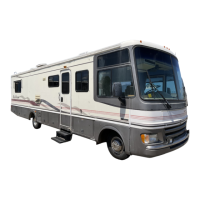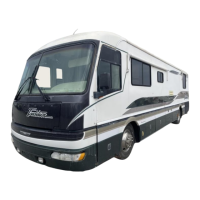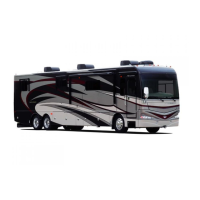Do you have a question about the Fleetwood 1997 Discovery and is the answer not in the manual?
Details warranty coverage for motor homes sold in the US and Canada.
Outlines the warranty terms and conditions for motor homes.
Specifies owner responsibilities for maintenance and warranty claims.
Defines dealer's responsibilities in the warranty process.
Details manufacturer's duties regarding warranty repairs.
Lists exclusions and limitations of the motor home warranty.
Overview of warranty programs and owner's rights and obligations.
Information on obtaining warranty service and contact numbers.
Procedure for reporting vehicle safety defects to NHTSA and Fleetwood.
Details contents of the package including manuals and safety information.
Explains VIN and FIN numbers for vehicle identification.
Identifies and describes various controls in the driver's compartment.
Details operation of the heating, ventilation, and air conditioning system.
Instructions for starting and operating the generator.
Information on the parking brake and its operation.
Operation of the vehicle's headlight system.
Instructions for using the windshield wipers and washer system.
How to use the auxiliary start system to start the engine.
Guidelines for proper and safe loading of the motor home.
Advice and precautions for towing trailers or vehicles.
Explains weight ratings and how to distribute load for safety.
Information on tire maintenance, inflation, and replacement.
Importance of proper tire inflation for safety and tire life.
Guidelines for proper use of seat belts for passenger safety.
Tips for operating the motor home safely, including handling differences.
Procedures for starting, operating, and shutting down the engine.
Explains automatic transmission operation and gear selection.
Information on the air brake system, components, and operation.
Warnings and precautions related to carbon monoxide hazards.
Guidelines and procedures for towing the motor home in emergencies.
Steps to determine vehicle weight at a weigh station.
Advice on securing and distributing cargo for optimal weight distribution.
Controls and operation of the hydraulic leveling system.
How to use the air dump system to deflate suspension air bags.
Information on operating and maintaining slider and torque pane windows.
Guidelines for using exterior storage compartments and packing supplies.
Tips for organizing and storing items within the motor home.
Care and maintenance for interior materials like fabrics and finishes.
General safety advice and precautions regarding fire hazards.
Information on testing, maintenance, and operation of the smoke detector.
Potential issues like premature wear and condensation from prolonged use.
Methods to reduce interior moisture and condensation.
Overview of the fresh water system components and operation.
How to connect to an external city water supply.
Procedures for filling the fresh water tank using city water or gravity.
Operation and characteristics of the on-board water pump.
Common water system problems and solutions.
Steps to clean and sanitize the fresh water tank and piping.
Components of the waste water system, including tanks and drains.
Procedures for draining and maintaining black and grey water tanks.
Tips for preventing clogs and maintaining holding tanks.
Components and function of the vehicle's primary electrical system.
Powering interior 12-volt systems, including batteries and converter.
Information on the motor home's battery systems and their maintenance.
How to disconnect batteries to prevent discharge during storage.
Procedures for checking battery condition, cleaning, and maintenance.
Overview of the AC power system, including generator and shore power.
How to connect the motor home to an external 120-volt AC power source.
Information on the LP-powered generator for electrical self-containment.
Crucial safety measures for operating the generator.
Operation of the automatic climate control for heating and cooling.
Explanation and testing of GFCI outlets for electrical safety.
Essential safety guidelines for handling and using LP gas.
Identification and function of LP gas system parts like tanks and regulators.
How temperature affects LP gas availability and system performance.
Procedures and safety warnings for refueling LP gas tanks.
Methods for detecting and verifying LP gas system leaks.
Operation and testing of the LP gas leak detection unit.
Operation and maintenance of the LP gas water heater.
Proper operation of the refrigerator, especially when parked and level.
Operation of the LP gas furnace and ensuring proper airflow.
Operating the roof-mounted air conditioners and filter maintenance.
Causes and solutions for TV and radio signal interference.
Information on additional appliances and their maintenance.
Routine maintenance for the motor home's exterior finish and components.
Methods for cleaning and removing water-soluble and non-water-soluble stains.
Maintenance for moving parts, hinges, latches, and sealants.
Care and maintenance instructions for the rubber roof material.
Procedures for inspecting and resealing joints to maintain waterproofing.
Care for interior appointments like fabrics, countertops, and paneling.
A comprehensive checklist for regular maintenance tasks.
Information on fuses, circuit breakers, and their replacement.
Specific sealant types for various exterior components.
Checklists to prepare the motor home for short-term or long-term storage.
Steps for preparing the motor home for storage periods under 60 days.
Detailed procedures for storing the motor home for extended periods.
Steps to prepare the motor home and its systems for winter conditions.
Procedures to protect the water system from freezing damage.
Steps to take when bringing the motor home out of storage.
Device that converts DC to AC power for appliances.
Maximum weight a specific axle is designed to carry.
Maximum combined weight of the motor home and towed load.
Electrical device that disconnects power to prevent shock.
Maximum allowable loaded weight of a towed vehicle or trailer.
Maximum allowable weight of the fully loaded motor home.
Weight of the motor home as built, without cargo or fluids.
Legal identification number for the vehicle, used for registration.
Details warranty coverage for motor homes sold in the US and Canada.
Outlines the warranty terms and conditions for motor homes.
Specifies owner responsibilities for maintenance and warranty claims.
Defines dealer's responsibilities in the warranty process.
Details manufacturer's duties regarding warranty repairs.
Lists exclusions and limitations of the motor home warranty.
Overview of warranty programs and owner's rights and obligations.
Information on obtaining warranty service and contact numbers.
Procedure for reporting vehicle safety defects to NHTSA and Fleetwood.
Details contents of the package including manuals and safety information.
Explains VIN and FIN numbers for vehicle identification.
Identifies and describes various controls in the driver's compartment.
Details operation of the heating, ventilation, and air conditioning system.
Instructions for starting and operating the generator.
Information on the parking brake and its operation.
Operation of the vehicle's headlight system.
Instructions for using the windshield wipers and washer system.
How to use the auxiliary start system to start the engine.
Guidelines for proper and safe loading of the motor home.
Advice and precautions for towing trailers or vehicles.
Explains weight ratings and how to distribute load for safety.
Information on tire maintenance, inflation, and replacement.
Importance of proper tire inflation for safety and tire life.
Guidelines for proper use of seat belts for passenger safety.
Tips for operating the motor home safely, including handling differences.
Procedures for starting, operating, and shutting down the engine.
Explains automatic transmission operation and gear selection.
Information on the air brake system, components, and operation.
Warnings and precautions related to carbon monoxide hazards.
Guidelines and procedures for towing the motor home in emergencies.
Steps to determine vehicle weight at a weigh station.
Advice on securing and distributing cargo for optimal weight distribution.
Controls and operation of the hydraulic leveling system.
How to use the air dump system to deflate suspension air bags.
Information on operating and maintaining slider and torque pane windows.
Guidelines for using exterior storage compartments and packing supplies.
Tips for organizing and storing items within the motor home.
Care and maintenance for interior materials like fabrics and finishes.
General safety advice and precautions regarding fire hazards.
Information on testing, maintenance, and operation of the smoke detector.
Potential issues like premature wear and condensation from prolonged use.
Methods to reduce interior moisture and condensation.
Overview of the fresh water system components and operation.
How to connect to an external city water supply.
Procedures for filling the fresh water tank using city water or gravity.
Operation and characteristics of the on-board water pump.
Common water system problems and solutions.
Steps to clean and sanitize the fresh water tank and piping.
Components of the waste water system, including tanks and drains.
Procedures for draining and maintaining black and grey water tanks.
Tips for preventing clogs and maintaining holding tanks.
Components and function of the vehicle's primary electrical system.
Powering interior 12-volt systems, including batteries and converter.
Information on the motor home's battery systems and their maintenance.
How to disconnect batteries to prevent discharge during storage.
Procedures for checking battery condition, cleaning, and maintenance.
Overview of the AC power system, including generator and shore power.
How to connect the motor home to an external 120-volt AC power source.
Information on the LP-powered generator for electrical self-containment.
Crucial safety measures for operating the generator.
Operation of the automatic climate control for heating and cooling.
Explanation and testing of GFCI outlets for electrical safety.
Essential safety guidelines for handling and using LP gas.
Identification and function of LP gas system parts like tanks and regulators.
How temperature affects LP gas availability and system performance.
Procedures and safety warnings for refueling LP gas tanks.
Methods for detecting and verifying LP gas system leaks.
Operation and testing of the LP gas leak detection unit.
Operation and maintenance of the LP gas water heater.
Proper operation of the refrigerator, especially when parked and level.
Operation of the LP gas furnace and ensuring proper airflow.
Operating the roof-mounted air conditioners and filter maintenance.
Causes and solutions for TV and radio signal interference.
Information on additional appliances and their maintenance.
Routine maintenance for the motor home's exterior finish and components.
Methods for cleaning and removing water-soluble and non-water-soluble stains.
Maintenance for moving parts, hinges, latches, and sealants.
Care and maintenance instructions for the rubber roof material.
Procedures for inspecting and resealing joints to maintain waterproofing.
Care for interior appointments like fabrics, countertops, and paneling.
A comprehensive checklist for regular maintenance tasks.
Information on fuses, circuit breakers, and their replacement.
Specific sealant types for various exterior components.
Checklists to prepare the motor home for short-term or long-term storage.
Steps for preparing the motor home for storage periods under 60 days.
Detailed procedures for storing the motor home for extended periods.
Steps to prepare the motor home and its systems for winter conditions.
Procedures to protect the water system from freezing damage.
Steps to take when bringing the motor home out of storage.
Device that converts DC to AC power for appliances.
Maximum weight a specific axle is designed to carry.
Maximum combined weight of the motor home and towed load.
Electrical device that disconnects power to prevent shock.
Maximum allowable loaded weight of a towed vehicle or trailer.
Maximum allowable weight of the fully loaded motor home.
Weight of the motor home as built, without cargo or fluids.
Legal identification number for the vehicle, used for registration.
| Model Year | 1997 |
|---|---|
| Make | Fleetwood |
| Model | Discovery |
| Fuel Capacity | 75 gallons |
| Width | 8.5 ft |
| Sleeping Capacity | 6 |
| Height | 11 feet |











